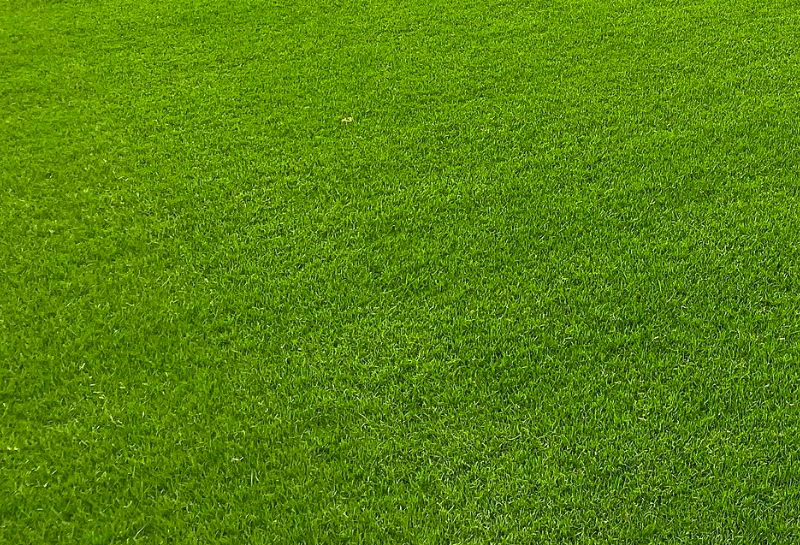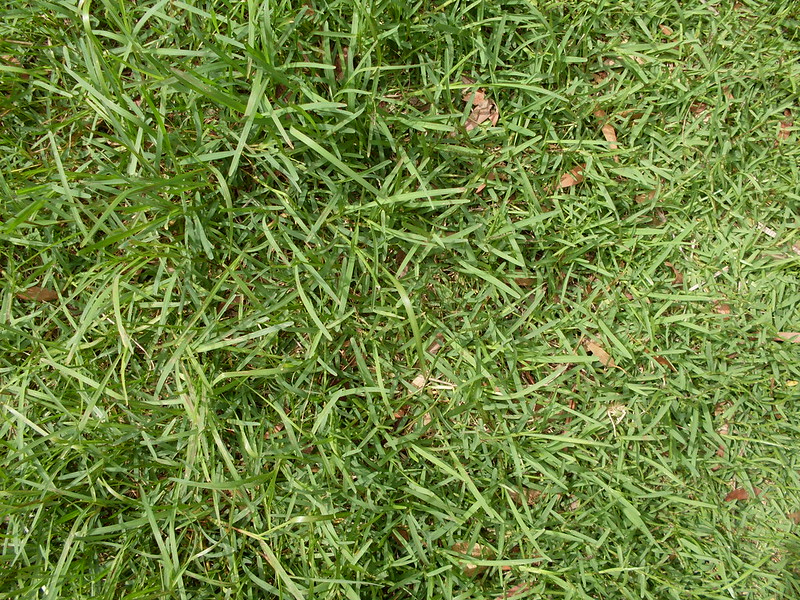
It can be tough to keep your lawn healthy with Wichita’s hot summers and cold winters, but choosing the best grass type for your backyard will get you started on the right foot.
Kansas is in the transition zone, meaning it’s between the cut-off for warm-season grasses and cool-season grasses. There are a few turf types that can handle Wichita’s temperature extremes and will suit your unique backyard conditions.
The four best grass types for Wichita are:

Matt Lavin | Flickr | CC BY-SA 2.0
1. Tall fescue
Turf-type tall fescue is a popular transition zone turfgrass because it is fairly low maintenance. Because it puts down deep roots that hold nutrients, it has higher heat tolerance and can keep its medium to deep green color longer into the summer as long as it’s kept watered.
Its deep roots also mean this grass is drought tolerant. Although it has good foot traffic tolerance, once it’s injured, it has a tough time recovering. Plan to reseed every few years to fill in bare spots or thin patches.
Tall fescue can grow in almost any soil condition. It can tolerate infertile, acidic, alkaline, and compact soil. It also resists disease and requires very little fertilizer.
Classification: Cool-season grass
Spreads by: Bunch-type grass
Shade tolerance: Moderate
Drought resistance: Moderate
Foot traffic tolerance: Moderate, but low ability to recuperate from wear
Maintenance needs: Moderate, but needs regular mowing
Mowing height: 2-4 inches
Potential for disease: Low to moderate with good care
Soil pH: 5.5-6.5
Soil type: Fertile, good drainage, but will tolerate a wider range of soil conditions
Other notes: Pick a “turf-type” tall fescue (TTTF) for best results
Grass Seed Options:
– Triple-Play Tall Fescue Grass Seed Blend (5000 sq ft)
– Eretz Kentucky 31 K31 Tall Fescue Grass Seed (choose your size)
– Pennington The Rebels Tall Fescue Grass Seed Mix (7 lb.)

Gilba Solutions Pty Ltd | Wikimedia Commons | CC BY-SA 4.0
2. Bermudagrass
Bermudagrass is one of the most popular warm-season lawns in the U.S. Newer varieties have developed better cold tolerance, meaning it’s appropriate for transition zones. Like tall fescue, this grass has deep roots that make it drought tolerant. However, it needs full sun, so skip this one if you have a lot of big trees in your yard.
Bermudagrass is sometimes used as sports turf, which tells you it can hold up well to plenty of foot traffic. It’s thick, aggressive growth means it crowds out weeds. That dense growth also means you’ll need to be diligent about dethatching.
Classification: Warm-season grass
Spreads by: Stolons and rhizomes
Shade tolerance: Low – prefers full sun
Drought resistance: High
Foot traffic tolerance: High
Maintenance needs: Moderate; needs regular dethatching and mowing
Mowing height: 1-2 inches
Potential for disease: Moderate
Soil pH: 6-6.5
Soil type: Tolerates most soil types
Other notes: Can spread aggressively into neighboring areas like flower beds
Grass Seed Options:
– Pennington Bermudagrass Bare Spot (5 lb. bag)
– Pennington Smart Seed Bermudagrass Mix (8.75-lb. bag)
– Scotts Turf Builder Bermudagrass (10-lb. bag)
– Hancock Seed Co. Bermudagrass (50-lb. bag)

John Tann | Flickr | CC BY-SA 2.0
3. Buffalograss
Buffalograss is one of the original American grasses. Left long, this grass covers the Great Plains prairies and was a favorite snack for bison. If you’re looking for a lower maintenance lawn, this is a great choice. Like other native plants, it requires less water to thrive and is less susceptible to disease and insects.
The downside to buffalograss is that it has an “open growth habit,” which essentially means it doesn’t produce a dense turf. The problem with that is it leaves room for weeds to grow. You can establish a strict weed control routine or embrace them (they do increase your yard’s ecological diversity after all). Weeds won’t be as much of a problem once buffalograss is established.
Classification: Warm-season grass
Spreads by: Stolons
Shade tolerance: Low – prefers direct sunlight
Drought resistance: High
Foot traffic tolerance: Low
Maintenance needs: Low – doesn’t need frequent mowing
Mowing height: 2-4 inches or leave unmowed
Potential for disease: Low
Soil pH: 6.5-7.5
Soil type: Not sandy soils
Other notes: Has a soft texture suitable for bare feet
Grass Seed Options:
– Everwilde Farms Buffalograss Seeds (1 lb. of seeds)
– Buffalograss seed (primed) (5-lb. bag)

Bill Wilson | Flickr | CC BY-SA 2.0
4. Zoysiagrass
Zoysiagrass is a beautiful turfgrass that’s been cultivated to survive in transition zones. With this type, the cultivar you choose matters, so check with the Wichita County Extension Office for recommendations for your area. Generally, Zoysia japonica has the best cold tolerance.
A dense grass, Zoysia holds up well to heavy foot traffic and can bounce back from injury. A thick turf also means less need for weed management. It will go dormant during a drought, but it usually won’t die, and it can survive light shade.
Classification: Warm-season grass
Spreads by: Stolons and rhizomes
Shade tolerance: Moderate – can survive light to partial shade
Drought resistance: High
Foot traffic tolerance: High
Maintenance needs: Moderate
Mowing height: 1-2.5 inches
Potential for disease: Low – not prone to disease and insects
Soil pH: 6-6.5
Soil type: Well-draining
Other notes: Keep your mower blade sharp if you have a Zoysia lawn or you risk tearing the leaf blade
Grass Plug and Seed Options:
– Zoysia Plugs (50 Large Grass Plugs)
– Zoysia Plugs (50 Full & Lush Grass Plugs)
– Zoysia Plugs (100 Plugs)
– Zoysia Emerald Grass Seeds (1/8 lb. of seeds)
– Zenith Zenith Grass Seeds (1/8 lb. of seeds)
How to choose the best grass type for your Wichita lawn
It’s important to know your lawn before you decide what to plant. Here are a few questions to ask yourself:
- What’s the best grass type for a shady lawn?
Tall fescue has the highest shade tolerance out of these grasses.
- What kind of grass should I plant in my sunny yard?
Buffalograss and bermudagrass will both thrive with plenty of direct sunlight.
- If I have kids, pets, and guests walking over my grass frequently, what grass should I plant?
Zoysiagrass is the way to go if you host a lot of backyard barbecues or have a dog racing circles in your grass.
- Which turf will grow with the least amount of work?
Buffalograss is adapted to thrive in the Kansas landscape. All of these grasses, though, are relatively low maintenance.
Get lawn care from a pro
It’s one thing to choose a grass type; it’s another thing to take care of it. There’s fertilization, mowing, edging, and weed control, which adds up to a lot of hours of work on the weekends. Instead, call a Lawn Love pro to take care of all your lawn maintenance needs. You’ll have a lawn the neighbors will envy without breaking a sweat.
Main photo credit: Frank Lloyd Wright’s Allen House in Wichita | bobistraveling | Flickr | CC BY-SA 2.0
Lawn Love participates in the Amazon Services LLC Associates Program, an affiliate advertising program. Lawn Love may earn revenue from products promoted in this article.